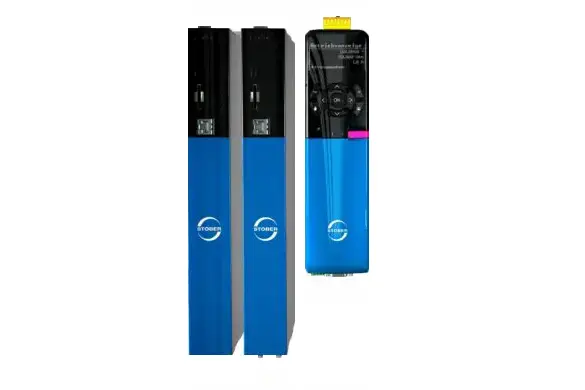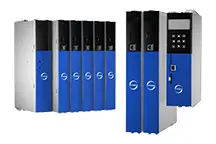
Safe. Safer. Safety technology.
When it comes to safety, similar questions always come up when designing machines:
Which safety functions are the right ones? How do I handle vertical axes? Are my safety functions flexible enough? Are they still high-performance?
We offer you a safety function for every risk assessment. If servicing is required, downtime and additional costs are minimal, as any service technician can replace a device with safety components. We have the solution: STOBER safety technology!
-
Extensive stop and movement functions:
- SS1, SS2, SDI, SLI, SLS, SOS, SSR, SLP.
- In addition to SS1, ten further safety functions can be parameterized and flexibly assigned.
-
Safe brake management:
- Safe control of up to two brakes (SBC)
- Testing and necessary test cycle monitoring (SBT)
- Fulfills the safety requirements of the DGUV for gravity-loaded vertical axes
- Safe monitoring: SDI, SLI, SLS, SOS, SSR, SLP also available as monitoring functions
-
Controlled stopping:
- Application-specific stopping of the drives if a limit value is exceeded or in the event of an emergency stop /li>
- Optional direct control or safe monitoring of the brake ramp
- Select any motor you need with manufacturer-neutral interfaces: Synchronous servo motors, asynchronous motors, linear motors, synchronous servo motors with a hollow shaft, etc.
-
Certifications in acc. with DIN EN 61800-5-2 and DIN EN ISO 13849-1:
- Safety Integrity Level (SIL): 3
- Performance Level (PL): e
- Category: 4
-
Implementable safety functions and stop categories in acc. with DIN EN 61800-5-2 and DIN EN ISO 13849-1:
- Safe Torque Off (STO)
STO switch-off time: Less than 50 ms - Stop category – Stop category 0
- Safe Stop 1 (time-delayed) – Safe Stop 1 (SS1-t)
- Stop category – Stop category 1
- Safe Torque Off (STO)
- Certifications in acc. with EN ISO 61800-5-2 and EN ISO 13849-1:
- Safety Integrity Level (SIL): 3
- Performance Level (PL): e
- Category: 4
- Implementable safety functions and stop categories in acc. with EN ISO 61800-5-2 and EN ISO 13849-1:
- Safe Torque Off (STO)
STO switch-off time: less than 60 ms - Stop category – Stop category 0
- Safe Stop 1 (time-delayed) – Safe Stop 1 (SS1-t)
- Stop category – Stop category 1
- Safe Torque Off (STO)
-
Certifications in acc. with DIN EN 61800-5-2 and DIN EN ISO 13849-1:
- Safety Integrity Level (SIL): 3
- Performance Level (PL): e
- Category: 4
-
Implementable stop functions in acc. with DIN EN 61800-5-2 and DIN EN ISO 13849-1:
- Safe Torque Off (STO); with suitable external circuitry also Safe Stop 1 (SS1-t), etc.
STO switch-off time: Less than 10 ms - Stop category – Stop category 0
- Safe Torque Off (STO); with suitable external circuitry also Safe Stop 1 (SS1-t), etc.
The SX6 is controlled via the secure Fail Safe over EtherCAT (FSoE) protocol and uses the existing EtherCAT® infrastructure.
Advanced safety functions up to SIL 3, PL e, Category 4.
- Safe stop functions according to EN 61800-5-2
- STO, SS1, SS2
- Safe motion functions according to EN 61800-5-2
- SDI, SLI, SLS, SOS, SSR
- Safe monitoring functions
- SDI-M, SLI-M
- Safely monitored speed
- SLS-M, SOS-M, SSR-M
- Safe braking functions
- SBC, SBT (expected to be available by the end of 2025)
- Other functions
- SRL, SSO
Made in Germany. Since 1934.
STOBER Product ID.
Do you need operating and assembly instructions, replacement part lists or notes on technical features of our products?
Thanks to the STOBER Product ID, you can get the information you need quickly and easily.
This might also interest you

High-efficiency drive controllers
Whether for high-performance systems, highly efficient multi-axis applications or compact modules – the 6th generation from STOBER always has the right drive controller on hand.
A safety function is the control function of a machine that reduces the various risks arising from the machine to an acceptable level.
Safe brake management in system automation is a complex and important topic. If it is neglected, harm can come to people and the machine!
In general, the term safety technology covers all technical devices that serve to reduce hazards to people and the environment.
















